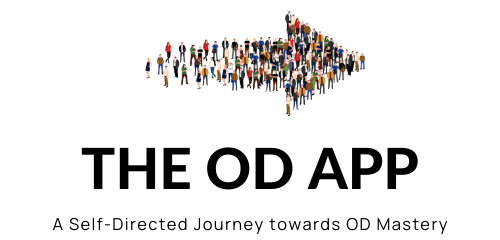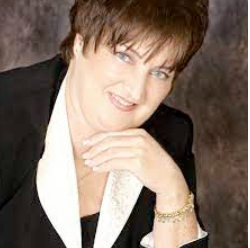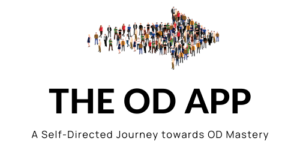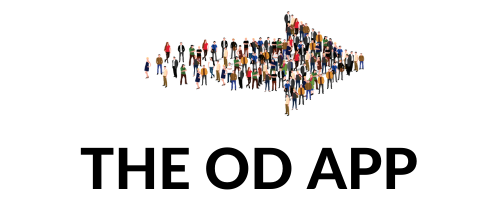Part I – How I became interested in DEI
My professional career began in a traditional Human Resource role with Motorola, in Scotland; and then with BBC Television, in Scotland and Wales. Over time I found I did not really enjoy the recruitment, policies, and procedures parts of HR and was much more motivated when working with groups. I discovered I had a natural talent for seeing the group dynamics playing out in front of me, and for facilitating brave discussions in safe spaces. I did not have a name for it then, but I began to realise that I was, albeit unconsciously, dipping my toes into the waters of Organizational Development (OD).
In 1985, I established my own consulting firm, Human Facets, and initially focused on design, development, and the facilitation of team building and strategic planning events. What motivated me to move from being a pure OD Consultant, to specializing in Diversity, Equity, and Inclusion (DEI), were the inequities that I consistently saw around me. When I saw discrimination and injustice operating at a societal level, community level, and at organizational levels in various dimensions including race, gender, disability, sexual orientation, etc., it spoke to something very deep in my core values around fairness and equity. When I further realised that these issues showed up, no matter what country I was working in, I became increasingly passionate and committed.
It did not seem to matter whether I was in Australia, Hong Kong, Germany, the United Kingdom, Canada, Latin America, or in parts of the United States. I saw evidence of oppression and inequity play out, and I wanted to use my voice and my knowledge as an advocate for change. I first wanted to raise to consciousness the biases – both reflexive and deliberative – and then to help make positive change happen, within organizations, by persuading leaders and managers that they needed to own their part of this and to acknowledge that they had some ‘skin in the game’. It was not OK to just delegate ‘diversity’ to the HR and training departments. Leadership needed to own the mission. DEI work, combined with my skills in OD, helped me to carve out that brave space where I would begin to understand what I later labeled the ‘Complexity of Inclusion’.
Inclusion is such a soft word, and we can tend to convince ourselves it is easy to be inclusive and that we are good at it. And yet I know that it takes work to grasp the myriad of ways in which we exclude others. I have seen people be excluded, talked down to, ignored, rendered invisible, and oppressed in so many subtle and obvious ways – Indigenous people in Australia; women all over the world; locals in Hong Kong interacting with ex-pats, and people who identify as LGBTQI in San Francisco. What I began to realise was that the challenges of oppression are constant and foundational, and the only thing that changes is the geography and the name of the dominant/privileged and subordinated groups. The problem is chronic, insidious, and endemic – and ignoring it does not make it go away.
Today I have six-million air miles from traveling the globe doing this work; I have six international clients who have won major Awards, including two clients who won the much-acclaimed Catalyst Award; and I have three psychometric assessment tools that specialise in Unconscious Bias and closing Inclusion and Gender skills gaps. A long way from the young Scottish lady who first arrived in the USA wondering why I needed to change the way I spelled behaviour and colour.
Part II – What is Diversity, Equity, Equality, and Inclusion?
The topic(s) surrounding DEI have evolved in the last 30+ years. When I began doing this work in 1985, much of the attention was around race and racism. In the USA, in particular, that meant paying attention to the relationship tensions between White and African American (Black) employees. Corporations made efforts to ‘level the playing field’ by complying with affirmative action hiring in an effort to shine a spotlight on the inequities of the talent pipeline. Resistance to these efforts showed up in conversations about ‘Reverse Discrimination’ and ‘What about us?’. Somewhere along that journey, other groups joined the conversation – other People of Color, which in the US meant Asian and Hispanic (now Latinx).
Today we use the term BIPOC to mean Black, Indigenous, People of Color. People who identified as LGBTQI also joined the conversation. At that time, what was not taken into account was how the nuances of race and ethnicity showed up in other countries. It was assumed that the Black/White debate in the USA transferred equally to all other countries, which it did not. We needed to respectfully ask and be curious to learn how it was that people in India, the Philippines, Malaysia, Indonesia, Burma, Malaysia, French speaking Africa, etc., viewed race. Who is considered dominant and who is subordinated? And is it about race and ethnicity, or about something else entirely – social class or religious differences, for example? Malaysia is a multiracial, multireligious, multilingual, and multicultural country where workers place high value on team building and cohesion, and where they look to their direct managers to be role models. Having a sense of belonging and fitting into the team is valued above the organizational values (https://www.persolkelly.com/news/harmony-through-diversity-in-the-malaysian-workforce/43350/).
Corporations in the USA also placed high value on a parallel conversation about gender diversity – how could we get more women promoted and, to use the euphemisms of the time, break the glass ceiling and pay attention to the sticky floor. Our work on race, gender, and sexual orientation was certainly not done; and yet, in the years that followed, attention shifted again – almost as if we were done with trying and now wanted to follow the next ‘bright, shiny object’. For a while, there was a movement toward ‘all diversity matters’ (paying more attention to diversity of thought), but that never really gained traction … perhaps because it sounded like a rationale for walking away from the discomfort of doing the work of exploring power, privilege, and inequities.
What did gain momentum was the concept of unconscious bias and the neuroscience of inclusion. That became the latest trend, and almost everyone in the field became a neuroscientist overnight (well, that is how it seemed for a while). We all have reflexive and deliberative behaviours, and no one gets to be a phenomenological exception. Unconscious bias does not go away just because you can learn about it, and it does have an impact on our ability to be inclusive of people who are different from us.
Part III – Diversity and Inclusion
Diversity and Inclusion are often used in the same sentence, almost as if they mean the same thing and are inextricably linked; and yet it is possible to have inclusion without diversity and to have diversity without inclusion. I have long contended that ‘companies hire for diversity and manage for similarities’. That causes diverse people to have to figure out how to assimilate in order to fit in with the needs and expectations of the dominant culture; therefore, not allowing diverse people to bring their best selves to work.
Before we take a look at the definitions for each of these terms, let’s pause and reflect on what it really takes to be a seasoned and skilled DEI/OD Practitioner. It is not a criterion to just ‘be diverse’. Being a woman, or a person who is LGBTQI, or Black, or any combination of the social-identity categories, does not necessarily qualify you to do this work; or, indeed, being a White male who is empathetic to the cause for diversity. Like every profession, there is a level of competence required, with specific skills and knowledge forming the foundations of the field.
There are five criteria that I use to measure competence for DEI consultants, whether they are external consultants or internal to a major organization:
First. An OD systems approach to working with clients, which includes the ability to think about presenting issues from five different levels, including the ability to see at all of these levels, sometimes simultaneously:
- Intrapersonal,
- Interpersonal,
- Group/Team,
- Organizational
- Societal
It is also critical to understand how to create experiential designs that allow participants to take the journey ‘from their head to their heart’, and back again: to enter the conversation safely, take a deeper dive into the topic(s), and then prepare to leave the conversation with aha moments and insights, but no harm done. I strongly believe that your overarching goal should be to leave people better than you found them, and to ensure the psychological safety of every participant. I am not a believer in creating punishing dialogue or making any individual or group feel ‘less than’, in order to make other people feel vindicated.
Second. A deep knowledge of the complexity of inclusion and the different social-identity issues that includes race, ethnicity, gender, gender identity, sexual orientation, generational differences, physical abilities, mental health challenges, etc., and the complexity of intersectionality.
Third. A deep understanding of concepts and the ever-evolving nature of these concepts – e.g., affinity bias, assimilation/covering, microaggressions, microassaults, microinequities, intersectionality, gender identity, gender expression, use of pronouns, etc.
Fourth. Exceptional facilitation skills and the ability to create and hold a psychologically safe container to enable brave and safe conversations across differences. The wisdom and knowledge to know that it is ‘all about them’ and not about you. As the Tao is quoted as saying, ‘Of the good leader [facilitator] let it be said, they did this themselves’ (Heider, 2015. The Tao of Leadership).
Fifth. The personality and passion to care about this work, while simultaneously managing the professional relationship boundaries with the client, participants, co-facilitators, and consulting colleagues
Part IV – Resources and Definitions
Bhavnani, K.-K., J. Foran, et al. (2003). Feminist Futures : Re-imagining Women, Culture and Development. London, Zed Books.
Bowser, B. P., & Hunt, Raymond G. (1981). Impacts of Racism on White Americans. Beverly Hills, CA, Sage Publications Inc.
Bretz (2003). Some thoughts on Internalized Oppression, Bretz.com.
Collins, P. H. (2002). Black Feminist thought. New York, N.Y., Routledge Publishers.
Cose, E. (1993). The Rage of a Privileged Class. New York, NY, Harper Perennial Publishers.
Elam, D. (1994). Feminism and Deconstruction. London, England, Routledge Press Inc.
Feagin, J. R. S., Melvin P. (1994). Living with Racism : The Black Middle Class Experience. Boston, Mass., Beacon Press.
Flammer, L. J. (2001). The Nature of Prejudice : Dimensions and Patterns of racism, sexism, classism and heterosexism among social groups. Social Psychology. Phoenix, Arizona, Temple University: 366.
Glenn, E. N. (2000). From Servitude to Service Work: Historical continuities in the Racial Division of Paid Productive Labor. Unequal Sisters : A multicultural Reader in U.S. Women’s history. V. L. Ruiz and E. C. DuBois. New York, Routledge: 436-465.
hooks, b. (2000). Feminism is for Everyone : Passionate Politics. Cambridge, MA, South End Press.
hooks, b. (2000). Feminist Theory : From Margin to Center. Cambridge, MA, South End Press Classics.
hooks, b. (2000b). Feminism is for Everyone : Passionate Politics. Cambridge, MA, South End Press.
James, K., C. Lovato, et al. (1994). “Social identity correlates of minority workers’ health.” Academy of Management Journal 37(2): 383 – 398.
Janeway, E. (1980). Powers of the Weak. New York, Alfred A. Knopf.
Johnson, Allan G., (2014) The Gender Knot: Unraveling our Patriarchal Legacy Temple University Press (3rd Edition). The Gender Knot
Johnson, Allan G., (2017) Privilege, Power and Difference. McGraw Hill Publishers (3rd Edition). Privilege, Power and Difference
Kivel, Paul (2017) Uprooting Racism: How White People can work for Racial Justice. New Society Publishers (4th Edition). Uprooting Racism
Ramazanoglu, C. (2003). Feminism and the Contradictions of the Oppressed, http://emedia.netlibrary.com.
Ruiz, V. L. and E. C. DuBois (2000). Unequal Sisters : A multicultural reader in U.S. Women’s history. New York, N.Y., Routledge.
Scott, J. C. (1990). Domination and the Art of Resistance. New Haven, Yale University Press.
Skevington, S. and D. Baker (1989). The Social Identity of Women. London, Sage Publishers.
Tajfel, H. and J. C. Turner (1986). The social identity theory of intergroup behavior. Psychology of intergroup relations. S. Worchel and W. J. A. (Eds.). Chicago, Nelson Hall Publisher: pp.7-24.
Tong, R. (1998). Feminist Thought : A more comprehensive introduction. Boulder, Colorado, Westview Press Inc.
Trompenaars, F. and C. Hamden-Turner (1998). Riding the Waves of Culture. New York, NY, McGraw Hill Publishers.
Turnbull, H. (2015). The Illusion of Inclusion. New York, NY, Business Expert Press Publishers
Wing Sue, Derald & Spanierman, Lisa Beth (2020) Microaggressions in Everyday Life. John Wiley & Sons (2nd Edition).
Definitions
Diversity is the unique combination of various identity dimensions that makes each of us different from and similar to others. These dimensions can include – but are not limited to – age, gender, gender identity, ethnic heritage, race, physical or mental abilities, sexual orientation, values, religion or spiritual practice, income, family status, education, and geographic location.
Equity Equity is defined as ‘the state, quality or ideal of being just, impartial, and fair’. The concept of equity is synonymous with fairness and justice. It is helpful to think of equity as not simply a desired state of affairs or a lofty value.
Equality is about ensuring that every individual has an equal opportunity to make the most of their lives and talents. Equality recognises that, historically, certain groups of people with protected characteristics, such as race, disability, sex and sexual orientation, have experienced discrimination.
Reality in many countries is that some people have much more than they need while the majority has much less than they need to survive. That creates a huge disparity of haves and have-nots.
Ideally we would create situations where everyone would have enough to not only survive but to thrive, and there would not be so many inequities. The other dynamic that tends to partner with the inequities is that Dominant Culture people tend to have privileges that subordinated groups do not have access to.
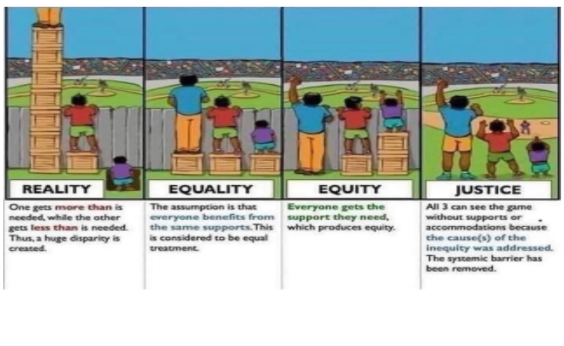
Inclusion is the ability to interact with people in a way that makes them feel that they belong, are valued, and welcome to be themselves. They feel able to bring their best selves to work.
Inclusion Complexity (Inclusion is a soft word) Many well-intentioned people believe they are being inclusive; however, in reality, being inclusive is complex and none of us behave in a purely inclusive manner.
Part V – What is the developmental journey for one to achieve this?
I will answer this question in two ways: What has my journey been and what would I recommend for you to consider.
My journey began with my attendance at an NTL Human Interaction Lab, where I first became aware of social justice issues, oppression, and the importance of understanding different lived experiences. It was not a diversity workshop, it was a personal growth experience and it opened my eyes, ears and heart to a world I had not been seeing. I was never able to not see that world again. It was impossible to go back to being naïve and unconsciously oblivious. As Socrates said, ‘(An unexamined life is not worth living’. Understanding the importance of the Use of Self is critical.
And for that reason, I would recommend an NTL Human Interaction Lab, or equivalent, to anyone, whether you want to be a Diversity Practitioner or not. I also attended every programme I could, to learn more and more about my subject matter. Having said that, nothing informed me more than working with clients, all over the world, and learning from them what the issues were, i.e., how oppression showed up in each country, in each industry, and in each client system. When I put all of that together, I realised I could stand tall as a subject-matter expert.
Over the years, I read extensively on any subject even closely related to DEI. I read fiction and non-fiction. I was privileged to have incredible clients, and I travelled the globe doing this work. While on that journey, I began to see that there were patterns of behaviour, mindsets, and attitudes that showed up no matter where I was in the world, and I realised that I could put together a series on conceptual models that would explain different aspects of DEI. I also wanted to continue my academic journey and was not satisfied with having only an undergraduate and master’s degree (in Mental Health counseling), so I decided to do my PhD. On the way to that, I gained a second Master of Human and Organizational Behaviour and Systems. My PhD dissertation was on the internalised oppression of women across cultures, and that work added deeper understanding and new knowledge to the conversation on how we internalise the negative messages we receive, from other groups, about who we are.
One of the models I developed that came out of all of my years of experience, and found its way into my book, The Illusion of Inclusion, is the Inclusion Complexity Model, which, for me, pulls together all of the dynamics that cause inclusion to be challenging.
The Inclusion Complexity Model
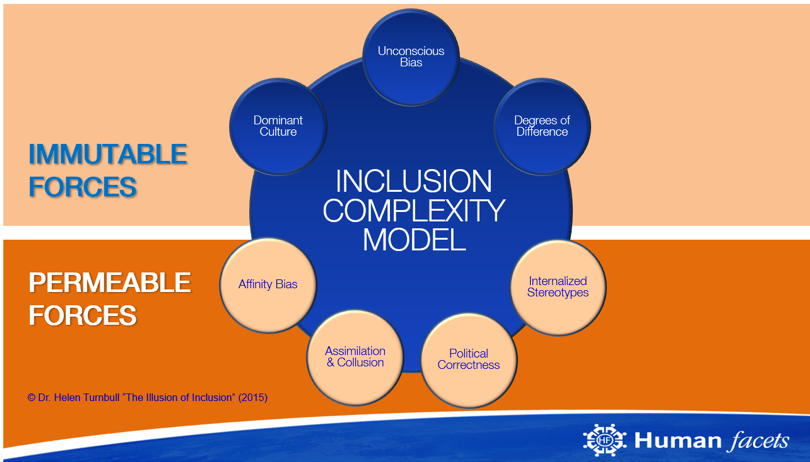
Key Elements of the Inclusion Complexity Model
- Immutable Forces
- Dominant and Subordinated groups
- Unconscious Bias/Reflexive and Deliberative behaviour
- Degrees of Difference and Intersectionality
- Permeable Forces
- Affinity Bias
- Assimilation/Covering
- Political Correctness
- Stereotype Threat
The Inclusion Complexity Model was developed by me and formed the genesis of my book, The Illusion of Inclusion. When I thought about the challenges of creating an inclusive work environment, I realised there were many factors and that some of these factors were not going to go away, no matter how much we knew about them; other factors I felt could be minimized if we more fully understood their presence and impact.
The three Immutable Forces are Dominant Culture Dynamics; Unconscious Bias, and Degrees of Difference. They are described in detail, by chapter, in my book The Illusion of Inclusion, referenced above, and for now I would simply say that they are all variables that will not go away and that if we are serious about creating inclusive workplaces, we need to do the work it takes to understand each of these dynamics more deeply and to be willing to work to mitigate against the power they wield.
The issue of Dominance will continue to be present; the only question is which groups will be dominant and what will be the ramifications of that dominance? Will we figure out how to work together, to peacefully coexist and to create inclusive environments where everyone benefits?
Unconscious Bias is never going to go away, it lives in our DNA and can revisit you in a microsecond. Your job is to catch your unconscious biases before making decisions and to limit their power by choosing not to act reflexively, in ways that limit other people’s opportunities, because of your biases and blindspots. Degrees of Difference recognises that there is diversity amongst what initially seems like a homogenous group. Men, for example, are diverse. When we suggest that we need to work on ‘Gender issues’ and we need to educate the men about what it is like for women in the workplace, we tend to take a broad-brush approach and apply the assumption that all men are the same (that all men fit the stereotype), and yet men are diverse too: there are white men, men of colour, heterosexual men, LGBTQIA+ men, gender non-binary men, men from different religions, men from different generations, men who are able-bodied, and men who have physical disabilities, etc. This is true for every other group – women, People of Color, ethnic minorities, religious groups, generational groups, etc. There is much more work to be done when we peel back the binary curtain and unpack the complexity of difference.
When you then take a look at the four Permeable Forces – Affinity Bias, Assimilation/Covering, Political Correctness, and Stereotype Threat – I would contend that becoming aware of their presence and impact gives us the power to choose. To choose not to hire people in our own image (affinity bias); to choose to manage when I have to assimilate to fit in and when I can find the courage to be my authentic self; to choose to have courageous conversations across difference and not be silenced by being politically correct; and to recognize the damage done to subordinated groups by taking on the negative messages perpetrated by the dominant culture(s), when we turn those messages on ourselves and each other.
More information can be found in ‘The Illusion of Inclusion’
The Inclusion Skills Model (ISM)
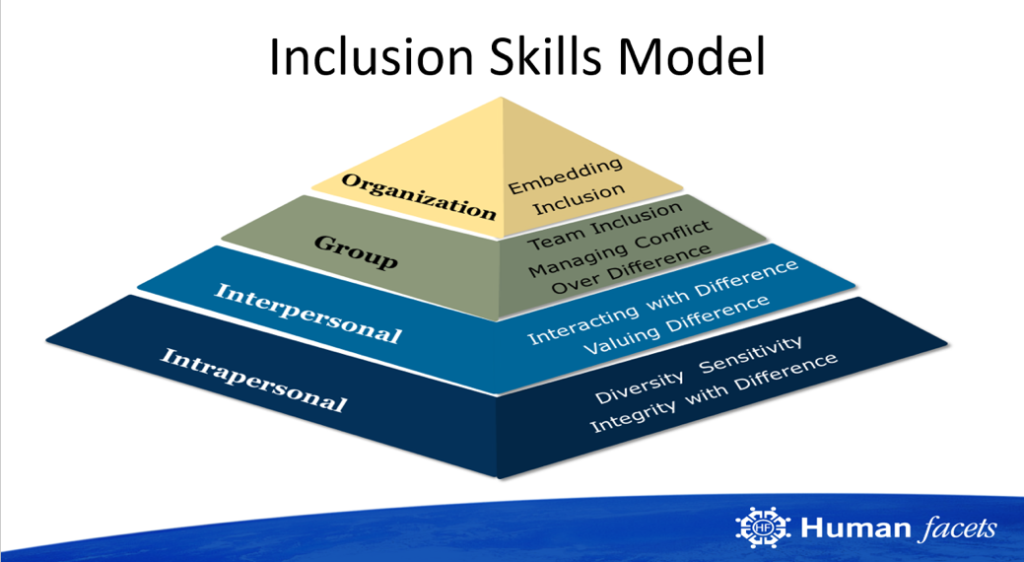
Key Elements of the Inclusion Skills Model and online assessment:
- Intrapersonal Skills
- Diversity Sensitivity
- Integrity with Difference
- Interpersonal Skills
- Interacting with Difference
- Valuing Difference
- Group-Level Skills
- Team Inclusion Skills
- Managing Conflict over Difference
- Organizational Skills
- Embedding Inclusion
- Sponsorship and Advocacy
The ISM Profile is designed to provide a way to measure Inclusion Skills gaps. The focus on inclusion is a key to success. It isn’t just about bringing in diverse talent, but also about ensuring that all team members feel like they belong and are encouraged to bring their authentic and best self to work. It is possible to have diversity and not inclusion. Inclusion is complex, and inclusion takes work to achieve.
The ISM provides specific and actionable behaviours that will directly correlate to the company leadership competencies. Employee engagement is greatly enhanced when inclusion is achieved.
ISM Profile Research
- Ten years researching the impact of inclusion on different social identity groups – gender, race, culture, generational, sexual orientation, and people with disabilities
- Conducted focus groups and 1:1 interviews with all diverse groups, with 5000+ people across different industries and geographies
- Compared and contrasted results within and across diverse groups, looking for differences in the stories/perception
The result. Identification of Seven Key Skills that can positively drive Inclusion:
- Diversity Sensitivity
- Integrity with Difference
- Valuing Difference
- Interacting with Difference
- Team Inclusion
- Managing Conflict Across Difference
- Embedding Inclusion
The ISM Profile is reliability- and validity-tested.
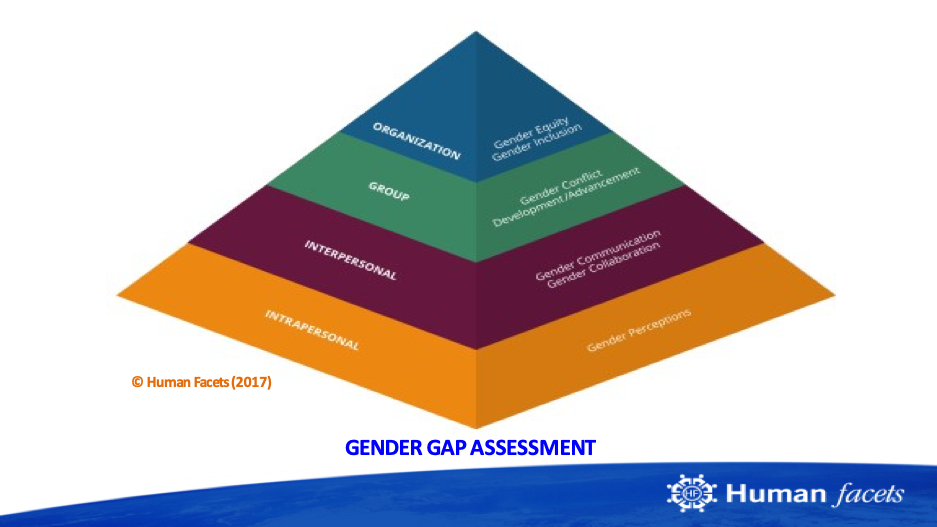
Key Elements of the Gender Gap Assessment:
- Intrapersonal
- Gender Perceptions
- Interpersonal
- Gender Communications
- Gender Collaboration
- Group
- Gender Conflict
- Development and Advancement of Women
- Organization
- Gender Equity
- Gender Inclusion
The Gender Gap Assessment was designed to provide a way to measure Gender Skills gaps, providing specific and actionable behaviours that highlight the areas requiring attention if organizations are to achieve gender parity. Gender acumen requires us to understand how to include all aspects of gender and gender identity and expression in our conversation.
Gender Gap Assessment Research
- Thirty years of field research, combined with a lifetime of experience, but of the corporate lived experience and understanding at a deep level the impact of gender inequity
- We conducted focus groups and 1:1 interviews with homogenous gender groups and cross-gender groups with 3000+ people across different industries and geographies
- Compared and contrasted results within and across diverse groups, looking for differences in the stories/perception
The result. Identification of Seven Key Skills that can positively close gender gaps and encourage necessary conversations across difference:
- Gender Perceptions
- Gender Communication
- Gender Collaboration
- Development and Advancement of Women
- Gender Conflict
- Gender Equity
- Embedding Gender Inclusion
The assessment is reliability- and validity- tested.
Books
Turnbull, H. (2016) The Illusion of Inclusion: Global Inclusion, Unconscious Bias and the Bottom Line. Business Executive Press. The Illusion of Inclusion
Published articles
- Academy of Strategic Management Journal, Volume 9, No. 1, 2010
- Journal of Organizational Culture, Communications and Conflict, Volume 15, No. 1 2011 – Inclusion Skills Measurement Profile
- Reflective Practitioner Journal, Volume 2, Issue 1, p.257, 2013
- Diversity Journal 5 articles: http://www.diversityjournal.com/?s=helen+turnbull
Videos
Dr. Turnbull has a TEDx Talk on the ‘Illusion of Inclusion’ – Watch here: https://www.youtube.com/watch?v=zdV8OpXhl2g&t=1s
You will also find a series of videos at https://www.humanfacets.com/audio-video/
Virtual and live webinars, keynotes, and workshops (customized for each client/audience)
- Becoming an Ally
- Being an Advocate/Partner across Difference – a deeper dive
- Gender Acumen Matters (2 days or 4 x 4 hours virtual)
- Inclusion Matters
- Race & Ethnicity Acumen Matters (2 days or 4 x 4 hours virtual)
- Intersectionality Unpacked
- Custom-Designed virtual events
- Keynotes – virtual and live
